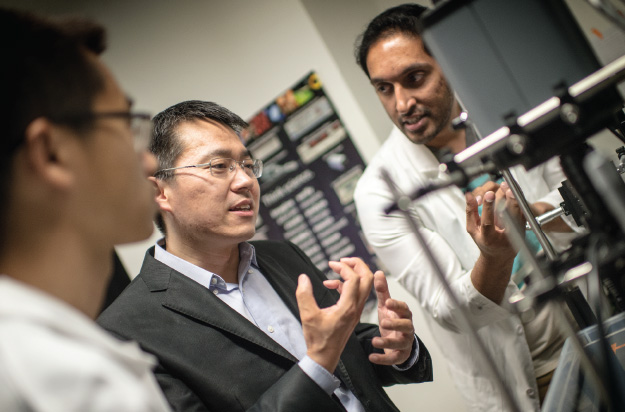Winter 2016: Energy Evolution
From carbon dioxide conversion to landfill mining, researchers at UTA are seeking viable alternative energy options.
Skip to content. Skip to main navigation.
From carbon dioxide conversion to landfill mining, researchers at UTA are seeking viable alternative energy options.
Found in everything from space shuttles to dental fillings, composite materials have thoroughly infiltrated modern society. But their potential is still greatly untapped, offering researchers ample opportunity for discovery.
Within the particle showers created at the Large Hadron Collider, answers to some of the universe’s mysteries are waiting.
Model systems like pigeons can help illuminate our own evolutionary and genomic history.
UT Arlington's tiny windmills are bringing renewable energy to a whole new scale.
The stability of our highways, pipelines, and even manholes is reaching a breaking point.
Scientists believe they have discovered a subatomic particle that is crucial to understanding the universe.
UT Arlington researchers unlock clues to the human body’s most mysterious and complex organ.
UT Arlington researchers probe the hidden world of microbes in search of renewable energy sources.
Wounded soldiers are benefiting from Robert Gatchel’s program that combines physical rehabilitation with treatment for post-traumatic stress disorder.
Tiny sensors implanted in the body show promise in combating acid reflux disease, pain and other health problems.
Nanotechnology researchers pursue hybrid silicon chips with life-saving potential.
Biomedical engineers combat diseases with procedures that are painless to patients.

For the fight against deadly tumors, clarity is key.
One of the more challenging aspects of treating cancer is capturing clear pictures of the disease in deep tissue. That’s why bioengineering Associate Professor Baohong Yuan has spent the past several years working to create a better imaging system to detect cancer tens of millimeters below the surface of the skin. His research is being funded with two grants from the Cancer Prevention and Research Institute of Texas worth a total of $1.9 million.
“The problem with current imaging is that what you get is not clear but more like an out-of-focus photo,” Dr. Yuan says. “For imaging of deeper tissues, you have to sacrifice resolution. This means if you want to see deep tissue, you cannot see too small. There’s a trade-off between the imaging depth and the resolution.”
He is using ultrasound-mediated techniques—combined with microparticles or nanoparticles that tumors attract—to image small but deep tumors. Exposed to ultrasound waves, the particles become temporarily fluorescent and can be detected by a non-invasive system that his team has developed.
“We want to provide much clearer images of microvessels in deeply seated small tumors,” Yuan says. “With that information, physicians could better target the tumors for elimination.”
The research is an application of biophotonics, an emerging area of scientific study that uses light and other forms of radiant energy to explore the inner-workings of living organisms. The technique enables researchers to see, measure, analyze, and manipulate tissue in new ways.
“You can see clearer, deeper, and smaller,” Yuan explains. “It is extremely useful to spot small tumors before they grow. If a tumor grows beyond 1 or 2 millimeters, it has to generate new blood vessels to provide nutrients and oxygen. The imaging technique can tell you if that’s happening.”
He notes that such information is helpful for doctors when determining appropriate treatments, such as surgery, radiation, or even spot-chemotherapy.
Additionally, sharper pictures could allow them to monitor or evaluate treatments like anti-angiogenic therapy, which can stop the growth of blood vessels in tumors.
“It could be a great assessment tool. If we are successful, this technique will enable clinicians to non-invasively visualize the details of microvasculature in tumors. When we can tell where the blood vessels for supplying nutrients and oxygen are located in tumors, we can better treat them.”
Ultimately, Yuan believes the system could be used to detect and diagnose breast, thyroid, prostate, skin, head, and neck tumors.